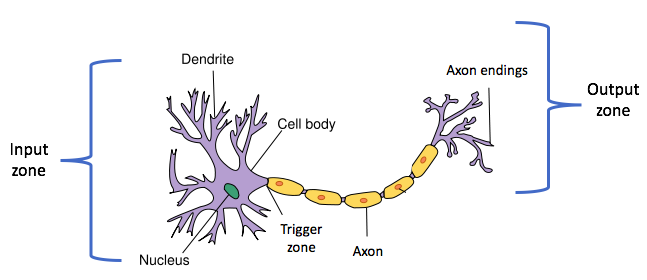Table of Contents |
The nervous system is a body system that collects, interprets, and responds to information about the environment. Neurons are nerve cells. These are the cells that allow the nervous system to collect information, interpret information, and respond to that information or stimuli from the environment.
Three different types of neurons play important roles in our nervous system functioning.
| Type of Neuron | Role |
|---|---|
| Sensory Neurons | The purpose of sensory neurons is to collect information about stimuli. Sensory neurons can be found throughout the body and can sense information like temperature and light (stimuli from the external environment) and the chemicals in your body's extracellular fluid (stimulus from the internal environment), to name just a few of the many examples. You have various types of sensory neurons that allow you to collect information about different types of stimuli. |
| Interneurons | Interneurons are neurons found in the central nervous system, which includes the brain and the spinal cord. They receive information that was collected from sensory neurons and process that information. |
| Motor Neurons | Motor neurons are the third type of neuron in the nervous system and their function is to relay information to muscles or glands. Then these muscles and glands are going to carry out some sort of response depending on the information that they receive. |
IN CONTEXT
Let's say that you're outside playing catch with a friend and your friend throws the ball to you. Sensory neurons would allow you to be able to collect that information; you would be able to see that the ball is coming toward you.
That information would then be sent to interneurons in your central nervous system, which would then determine what an appropriate response would be. Let's say that your central nervous system determines that an appropriate response would be to lift your arms and to catch the ball.
That information is then sent to motor neurons, which relay that information to muscles or glands. If the central nervous system decides that you should lift your arms to catch the ball, that information would then be sent to the muscles in your arms. You'd be able to lift your arms up and then catch the ball.
That's how those three types of neurons work together to collect, interpret, and respond to stimuli.
Take a look at the labeled diagram of a neuron below.

The dendrite is an extension of the cell body of the neuron with the nucleus in the middle.
The section as a whole is called the input zone and is the location where information enters the neuron. Information will enter through the dendrites and travel in towards the cell body, where you then have a little location called the trigger zone. The information will travel towards the trigger zone, and then towards the axon. The long, slender part of the neuron is called the axon.
Information is coming in through the dendrites, through the cell body, down to the trigger zone, and along the axon. Once information gets down to the axon, it travels through the axon endings and then to the output zone.
At the end of this output zone, you might have another neuron. This neuron has its dendrites, cell body, axon, and axon endings. Then the information can then be relayed from the axon endings of this neuron to the dendrites of the next neuron. That message will be carried through this neuron to the next neuron, or it could also be passed on to a muscle cell or to a gland cell to relay information.
Source: THIS WORK IS ADAPTED FROM SOPHIA AUTHOR AMANDA SODERLIND